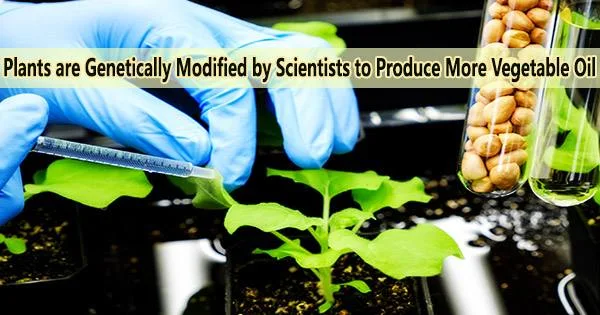A plant protein that causes oil to build up in plant seeds and edible nuts has been successfully genetically engineered by researchers from Nanyang Technological University, Singapore (NTU Singapore).
The model plant Arabidopsis gathered 15 to 18% more oil in its seeds when it was grown with the changed protein under laboratory conditions, demonstrating their patent-pending technology.
The farming industry’s holy grail is figuring out how to increase the amount of oil that crops produce in their seeds. The majority of oil-producing plants, such as oil palm, soybean, sunflower, rapeseed, and peanut, already contain a significant proportion of oil in their fruits or seeds, and standard crop crossbreeding techniques make it difficult to enhance their oil content.
Vegetable oils are commonly used in food processing, biofuels, soaps and perfumes, and the global market for them is estimated to be worth US$241.4 billion in 2021 and is expected to increase to US$ 324.1 billion by 2027. By decreasing the quantity of arable land required for oil-producing crops, increasing the output of oil from plants could aid the global effort to achieve sustainability.
The secret to helping plants store more oil in their seeds is one of their proteins called WRINKLED1 (WRI1). Scientists have known for over two decades that WRI1 plays an important role in controlling plant seed oil production.
Now for the first time, a high-resolution structure of WRI1 has been imaged and reported by the NTU team, jointly led by Associate Professor Gao Yonggui and Assistant Professor Ma Wei from the School of Biological Sciences.
The authors described the chemical structure of WRI1 and how it links to plant DNA to instruct the plant how much oil to store in its seeds in a paper published in the scientific journal Science Advances.
Based on the knowledge provided by the WRI1-DNA complex’s atomic structure, the scientists changed WRI1 to increase its affinity for DNA in an effort to increase oil output. With this method, various variants of WRI1 were created after particular parts of WRI1 were chosen for changes to enhance its binding to DNA.
Plant seed oil is vital for the human diet and is used in many important industrial applications. Global demand for plant oil is increasing very quickly and our research contributes to efforts to improve seed oil production in a sustainable manner, and potentially reducing the environmental impact of agriculture.
Assistant Professor Ma Wei
The capability of these potential WRI1s to stimulate oil synthesis in plant cells was then evaluated by additional testing. The scientists demonstrated that their modified versions of WRI1 boosted DNA binding ten times more than the original WRI1, which raised the oil content in the plant’s seeds.
Assoc Prof Gao, a structural biologist said: “Being able to see exactly what WRI1 looks like and how it binds to DNA that is responsible for oil production in the plant was the key to understanding the entire process. WRI1 is an essential regulator that informs the plant how much oil to store in its seeds. Once we were able to visualise the ‘lock’, we then engineered the ‘key’ that can unlock the potential of WRI1.”
How modifying WRI1 works
The team discovered this DNA binding region was highly conserved by analyzing at the atomic level the crystal structure of the WRI1 protein and the double helix DNA strands that it binds. This indicates that there were few to no mutations, which raises the possibility that it could be a typical binding mechanism for numerous plant species.
The scientists then looked to tweak WRI1 in order to increase the protein’s affinity for its target DNA by using this crystal structure of WRI1 as its “target”. The target plant cells are then given the instructions for coding this changed WRI1 protein, and the plant will use this new “set of instructions” going forward to generate WRI1.
Both the changed protein and the unmodified form of WRI1 were injected into Nicotiana benthamiana leaves in lab tests to observe how the modified protein influences oil accumulation. Triacylglycerol levels, a significant dietary lipid found in fats and oils, were then measured.
The modified WRI1 protein generated more significant spikes in triacylglycerol production compared to the control plant introduced with the WRI1 unmodified form.
It was discovered via subsequent research that the oil content in the seeds of the transformed Arabidopsis thaliana was higher than that of the unmodified variety. The descendants of this genetically altered plant will likewise have the altered WRI1 protein and have seeds that contain more oil.
Asst Prof Ma, a plant molecular biologist who has been studying WRI1 since his postdoctoral training, said modifying WRI1 to improve its binding to DNA was a logical move for the team.
“We know that WRI1 is a protein that binds to a plant’s DNA sequence and sets off a specific chain of instructions that regulates the accumulation of oils in the seeds. The stronger the binding the more oil the plant will concentrate in its seeds. Therefore, we chose to improve this portion of WRI1 that binds to its target DNA, which is highly conserved across many seed-bearing plants. Being highly conserved means many species of plants will have the exact same mechanism that can be modified, so we should be able to translate our oil-yielding modification easily to many different types of crops in future.” Asst Prof Ma explained.
“Plant seed oil is vital for the human diet and is used in many important industrial applications. Global demand for plant oil is increasing very quickly and our research contributes to efforts to improve seed oil production in a sustainable manner, and potentially reducing the environmental impact of agriculture.” Asst Prof Ma added.
The team is now seeking industry partners to help them commercialize their technology after filing a patent application through NTUitive, the university’s innovation and entrepreneurship division.
This research is aligned with the NTU2025 strategic plan and the University’s Sustainability Manifesto, where it aims to research and develop new technologies towards a greener future.
Giving an independent expert comment, Michael Fam Chair Professor William Chen, Director of Food Science & Technology Programme at NTU, said there are a few ways to tackle world hunger, including by increasing the amount of food produced or increasing the calories and nutritional value of the food produced.
“In a world that has limited arable land for agriculture, advanced technologies to grow more food with higher nutrition value is required if we hope to tackle world hunger. When we can increase the fat content in edible seeds and nuts, a person can eat a lesser amount but still feel full, due to the increase in calories consumed,” said Prof Chen, a food security expert who was not involved in this study.
“So instead of growing more crops to feed more people, we should also look at methods where the crops grown have more calories and nutrition, so that the same amount of food can feed more people.”
The NTU study is supported by Ministry of Education (MOE) of Singapore Tier 1 and Tier 2 grants, which usually awards research projects on a competitive basis up to $200,000 and $1 million respectively.
















